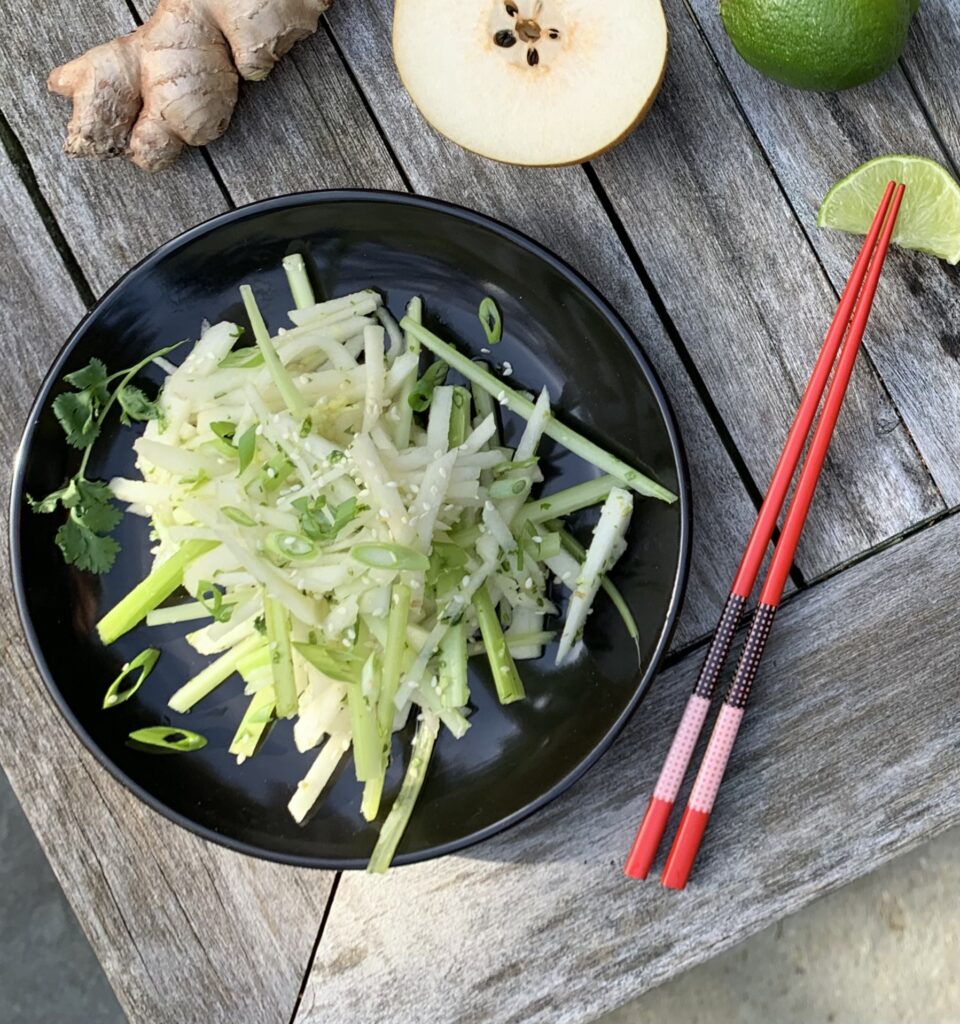A month of celebratory food and drink can play havoc with gut health. During the holidays we tend to eat fewer fiber-rich fruits and vegetables and more refined grains, sugar and alcohol. Eating less fiber can affect our bowel regularity—neither desirable nor good for managing our weight, and provide less food for gut biome.
Focusing more on health now that the holidays are over, you can care for your gut biome with the food you eat. Fiber-rich pears help celebrate National Pear Month, and work as a prebiotic—food, for our microbiome. Learn more about gut health and make this Ginger-Lime-Chili Asian Pear Slaw.
What is the gut biome?
The microbiome in our gut consists of microbes—bacteria and funguses. Bacteria has been studied the most, but so much more research is needed to fully understand their importance to our health and function.
Collectively, there are millions of strains of bacteria. Initially, we inherit our microbiome from our mothers. But it soon diversifies and grows as we introduce and feed new microbes with what we eat.
How does our gut biome affect our health?
Gut biome acts like a “second brain” because it communicates with our nervous system, which is connected to the brain, and controls how our immune system responds to infection. More healthy and diverse microbes may improve our ability to fight infection.
Our microbes breakdown fiber by fermenting it to make short chain fatty acids from fiber. This is important because our body can’t breakdown fiber on it’s own. As a byproduct of fiber fermentation, the bacteria make short-chain fatty acids which nourish the colon cells. The short chain fatty acids have been linked with lowering the risk of inflammatory diseases, heart disease, type 2 diabetes, obesity and other conditions like colon cancer.
Our microbes also help us metabolize alcohol, which is a common part of holiday celebrations. They may also help manage inflammation caused by consuming too much.
How does what we eat help it?
Because our microbiome ferments fiber for energy, eating plenty of fiber is the key to a healthy gut. Including a variety of fiber is thought to support the diversity of microbes.
Eating food with fiber can help diversify and nourish your gut bacteria. Eating fiber rich foods—vegetables, fruits, whole grains, legumes, nuts and seeds, is linked to making more short chain fatty acids. Eating a variety of foods with fiber diversifies the microbes in your gut.
Find out how much fiber you need and what foods have fiber in this video. In this recipe the pear, celery, ginger, pepper even cilantro are prebiotic.
There are a number Asian pear varieties you can use such as Daisu Li, Arirang and Shinsui. Choose one that is firm. Don’t like pears? Alternatives are the spice of life—try this recipe with apples or jicama in place of pears.
Gingerol in ginger is an active compound that is good for the gut. Helping to relieve nausea, gingerol is also chemically related to capsaicin, the spicy compound in chilis that can help reduce pain.
How to serve this recipe?
- Tacos of any kind- fish, vegan bean, pork or chicken.
- A side to oven roasted poultry and root vegetables.
- Paired with seafood.
- As a complement to pot stickers or pad Thai.
- Piled on a burger.
- On top of a salad or whole-grain bowl.
Ginger-Lime-Chili Asian Pear Slaw
Asian pears, also called apple pears, balance the spicy ginger-chili and tangy lime with sweet crunch.
Makes 4 servings
Prep time: 13 minutes
Cook time: 0 minutes
Total time: 15 minutes
What you’ll need:
- 2 large stalks celery, julienned
- 2 large Asian pears (or other firm pear), peeled and julienned
- ½ cup fresh cilantro, finely chopped
- 2 scallions, thinly sliced
- ½ inch fresh ginger, finely grated
- 2 tablespoons lime juice
- 2 tablespoons rice vinegar
- ¼ teaspoon Thai chili pepper, very finely chopped
- 2 teaspoons black sesame seeds
Steps to make:
Step 1
In large mixing bowl, whisk together the ginger, lime juice, and rice vinegar. Add the celery, pears, cilantro, scallions and chili pepper. Toss and let stand for a few minutes. Add the sesame seeds and toss just before serving.
Nutrition (12/2/2021)
Per serving: 78.5 calories; 1.5 g protein; 17.6 g carbohydrates; 5.8 g fiber; 0 g added sugar; 1.2 g total fat; 0.04 g saturated fat; 0.10 g monounsaturated fat; 0.1 g polyunsaturated fat; 0 mg cholesterol; 28.3 mg sodium
